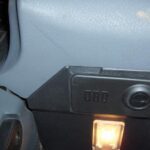Encountering a check engine light (CEL) on your motorcycle can be unsettling. It’s a signal from your bike’s onboard computer indicating that something isn’t functioning as expected. For modern motorcycles, especially those adhering to OBD2 standards, understanding what a CEL is and how to address it using an OBD2 scanner is crucial for maintenance and troubleshooting.
Understanding the Check Engine Light (CEL)
The Check Engine Light, often abbreviated as CEL, is a warning light in your motorcycle’s instrument cluster. It’s part of the onboard diagnostics system, designed to monitor various aspects of your bike’s engine and emissions systems. When the system detects an issue outside of normal parameters, it illuminates the CEL to alert the rider. This light can sometimes be referred to as a malfunction indicator lamp (MIL).
Ignoring a CEL is generally not advisable, as it indicates a potential problem that could range from minor to severe. While sometimes a CEL might appear due to a temporary sensor glitch, persistent or frequently recurring lights often point to underlying issues that need attention.
OBD2 and Your Motorcycle: A Diagnostic Window
OBD2, or On-Board Diagnostics II, is a standardized system used in vehicles, including many modern motorcycles, to monitor and report on vehicle performance and emissions. It provides a standardized port and communication protocol that allows diagnostic tools, like OBD2 scanners, to interface with the motorcycle’s computer system.
This standardization is incredibly beneficial for motorcycle owners. Instead of relying solely on dealership-specific tools, you can use widely available and often affordable OBD2 scanners to:
- Read Diagnostic Trouble Codes (DTCs): When a CEL illuminates, the OBD2 system stores a DTC, which is a code corresponding to the detected problem. Scanners can retrieve these codes, giving you a starting point for diagnosis.
- Clear Codes: After addressing the issue causing the CEL, an OBD2 scanner can often be used to clear the stored DTCs and turn off the check engine light.
- Monitor Live Data: More advanced scanners can display real-time data from your motorcycle’s sensors, such as engine temperature, RPM, and sensor readings, aiding in more complex diagnostics.
Common Causes for a CEL and OBD2 Use
Various issues can trigger a CEL on an OBD2-compliant motorcycle. Some common scenarios include:
- Sensor Malfunctions: Faulty oxygen sensors, crankshaft position sensors, or other engine management sensors.
- Emissions System Problems: Issues with the exhaust system, catalytic converter, or evaporative emissions control.
- Engine Performance Issues: Misfires, fuel delivery problems, or timing issues.
- Loose Gas Cap: Believe it or not, sometimes a simple loose gas cap can trigger a CEL due to evaporative emission system monitoring.
- Running Engine on a Stand: As illustrated in a forum discussion, running a motorcycle on a rear stand in gear, especially when throttling, can confuse the traction control and ABS systems, potentially triggering a CEL. This happens because the system detects rear wheel spin without corresponding front wheel rotation, interpreting it as a fault.
In each of these situations, an OBD2 scanner becomes invaluable. By reading the DTC, you can narrow down the potential cause. For instance, a code related to the oxygen sensor would point you towards the exhaust system and sensor functionality.
Troubleshooting CELs with OBD2 Scanners: A Practical Example
Consider the experience of a motorcycle owner who encountered a CEL after running their Yamaha MT-10 on a rear stand. They used an SCT OBD2 scanner (originally for a car) with an OBD2 to Yamaha 4-pin adapter. Initially, they faced difficulties clearing the code.
Several suggestions emerged from online communities to resolve this, highlighting common troubleshooting steps:
- Verify Adapter Compatibility: Ensure the 4-pin adapter is correctly wired and compatible with both the motorcycle and the OBD2 scanner. Incorrect wiring is a common issue with aftermarket adapters.
- Scanner Compatibility: While OBD2 is a standard, some scanners may have compatibility issues with certain motorcycle makes or models. Trying a different scanner, especially one known to work with motorcycles, might be necessary.
- Software/App-Based Scanners: Modern solutions include using Bluetooth OBD2 adapters paired with smartphone apps. These apps can sometimes offer better motorcycle-specific diagnostics and code clearing capabilities compared to generic handheld scanners. In the example, a user successfully cleared their CEL using a cheap Wi-Fi OBD2 adapter and a phone app, suggesting that scanner compatibility was the initial hurdle.
Conclusion: Empowering Motorcycle Diagnostics with OBD2
Understanding “What Is A Cel For Obd2” empowers motorcycle owners to take a more proactive role in their bike’s maintenance. The CEL is an early warning system, and OBD2 scanners are the tools to decipher its messages. While they are not a replacement for professional mechanic services for complex issues, OBD2 scanners are invaluable for diagnosing common problems, clearing codes after repairs, and gaining a deeper understanding of your motorcycle’s health. By investing in a compatible OBD2 scanner and understanding how to use it, you can save time, money, and keep your motorcycle running smoothly.
